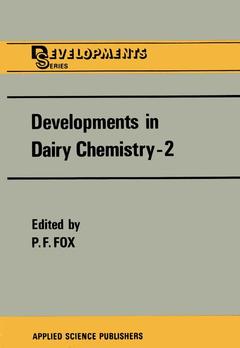Description
Developments in Dairy Chemistry—2, 1983
Lipids
Coordinator: Fox P. F.
Language: English
Publication date: 06-2012
430 p. · 15.2x22.9 cm · Paperback
430 p. · 15.2x22.9 cm · Paperback
Description
/li>Contents
/li>
Many of the desirable flavour and textural attributes of dairy products are due to their lipid components; consequently, milk lipids have, tradi tionally, been highly valued, in fact to the exclusion of other milk components in many cases. Today, milk is a major source of dietary lipids in western diets and although consumption of milk fat in the form of butter has declined in some countries, this has been offset in many cases by increasing consumption of cheese and fermented liquid dairy products. This text on milk lipids is the second in a series entitled Developments in Dairy Chemistry, the first being devoted to milk proteins. The series is produced as a co-ordinated treatise on dairy chemistry with the objective of providing an authoritative reference source for lecturers, researchers and advanced students. The biosynthesis, chemical, physical and nutritional properties of milk lipids have been reviewed in eight chapters by world experts. However, space does not permit consideration of the more product-related aspects of milk lipids which play major functional roles in several dairy products, especially cheese, dehydrated milks and butter.
1. The Composition and Structure of Milk Lipids.- 2. Influence of Nutritional Factors on the Yield, Composition and Physical Properties of Milk Fat.- 3. Origin of Milk Fat Globules and the Nature of the Milk Fat Globule Membrane.- 4. Physical Chemistry of Milk Fat Globules.- 5. Physical Properties and Modification of Milk Fat.- 6. Lipolytic Enzymes and Hydrolytic Rancidity in Milk and Milk Products.- 7. Lipid Oxidation.- 8. The Nutritional Significance of Lipids.
© 2024 LAVOISIER S.A.S.
These books may interest you

Dairy Chemistry and Biochemistry 68.56 €

Dairy Chemistry and Biochemistry 94.94 €



